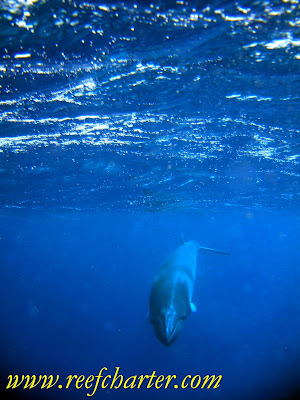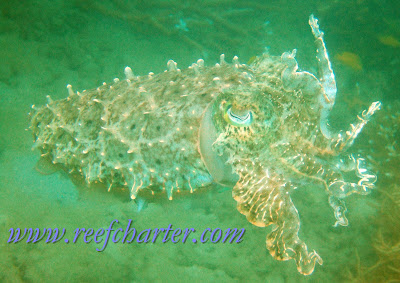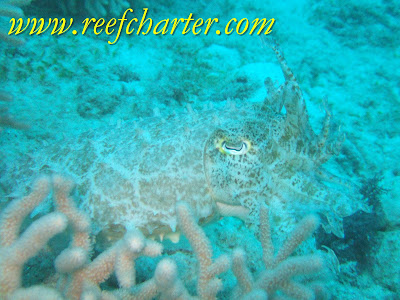‘Why are fish so brightly coloured?’ This is one of the questions most commonly asked by our guests.
Reef fish are able to see colour. Their bright colours are important in species recognition and in the determination of sex. Some species, such as angelfish, have juvenile patterns that are totally different to the adults. The different colour patterns of juveniles may prevent adults from seeing them as a potential threat to territories or as reproductive partners. They also use their colours to blend with the environment is an import way to ambush prey and to hide from predators.
Category: Species-of-the-Reef
Minke Whales – Species of the Reef
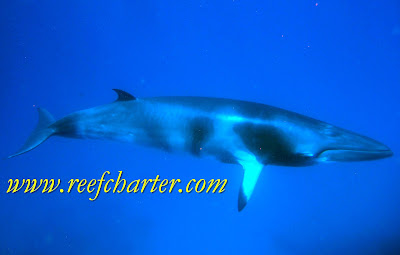
The Minke whales migrate from southern waters off Victoria to the northern areas of the Great Barrier Reef from about June every year. They grow to about 8m (26′) log and adults can weigh about 6 tonnes.
This young Minke whale decided to cruise around one of our dive sites on the outer reef. The curious young fellow was very intrigued with these strange creatures wearing bottles and blowing bubbles constantly. Jonny our intrepid young dive instructor happily snapped these photos as Fred swam around the boat and divers.
More on the Dwarf Minke Project can be found at the CRC Reef Research website.
More on the Dwarf Minke Project can be found at the CRC Reef Research website.
Angelfish – Species of the Reef
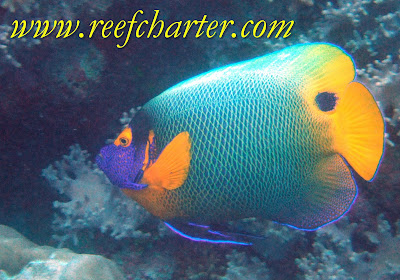
This is another of the vibrant and colourful fish found commonly seen our our trips to the Great Barrier Reef. There are over 80 different species of Angelfish. Most of which are about 30 cm (12″) long. Most of the different species exhibit a friendly and curious personality and often come over to investigate what the divers are doing on their turf. Smaller species such as the bi-coloured angel are very popular with home aquariums. Angel fish are found at all levels of the bommie fields, from the surface to swimming around the base of the reef formations and seabed.
The angel fish changes colours as it reaches maturity, and can also change sex if the male in the group disappears. If this happens the dominate female in the group will then become the male. The angel fish releases it’s eggs to float with the plankton until hatched.
The angel fish changes colours as it reaches maturity, and can also change sex if the male in the group disappears. If this happens the dominate female in the group will then become the male. The angel fish releases it’s eggs to float with the plankton until hatched.
Cuttlefish – Species of the Reef
This is one of the coolest fish on the reef or one of my favourites anyway. He just hangs out relaxed taking everything in his stride. They can often be seen hanging on the back edges of the reef and the juveniles often hang out by our mooring lines. The cuttlefish is related the squid, octopus and nautilus. The cuttle fish can also change colour (as the photo below demonstrates) and uses ink to defend itself.
The bone inside the cuttlefish is used for birds in the home and is often washed up on the beach or seen drifting on the ocean.
A couple of interesting facts about the cuttlefish are that they have amongst the best eyesight in the world although they do not differentiate colour the same as we do. The other fact is they have three hearts and green-blue blood instead of the usual red. Maybe this is why they act so cool, they have similar characteristics to the Vulcans from Star Trek.
The bone inside the cuttlefish is used for birds in the home and is often washed up on the beach or seen drifting on the ocean.
A couple of interesting facts about the cuttlefish are that they have amongst the best eyesight in the world although they do not differentiate colour the same as we do. The other fact is they have three hearts and green-blue blood instead of the usual red. Maybe this is why they act so cool, they have similar characteristics to the Vulcans from Star Trek.
